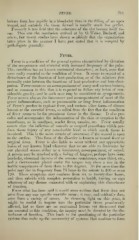Page 701 - My FlipBook
P. 701
FEVER. 711 ;
lations form less rapidly in a blood-clot than in the filling of an open
wound, and certainly the tissue formed is usually much less perfect.
Formerly it was held that the substance of the clot became itself tis-
sue. This was the conclusion arrived at by O.Weber, Budnoif, and
others, but recent studies have shown so plainly that the organization
takes place in the manner I have just stated that it is accepted by
pathologists generally.
Fever.
Fever is a condition of tlie general system characterized by elevation
of the temperature and attended with increased frequency of the pulse.
This condition has no known anatomical characters ; at least, none that
seem really essential to the condition of fever. It seems to consist of a
disturbance of the function of heat-production, or of the relations that
normally exist between the functions of heat-production and heat-dissi-
pation. Fever occurs as an accompaniment of many and various lesions
and so common is this that it is expected to follow any lesion of con-
siderable gravity, and in such cases may be considered as symptomatic.
Fever occurs also as the forerunner and accompaniment of most o^ the
grave inflammations, such as pneumonitis or lung fever, inflammation
of Peyer's patches in typhoid fever, and various other forms of disease
known as the essential fevers, so called from the fact that the condition
of fever seems to be the prominent factor in tlie disease. It also pre-
cedes and accompanies the inflammation of the skin or eruption in the
exanthems, as in smallpox, scarlet fever, measles, etc. Fever usually
occurs after the infliction of wounds or surgical procedures which pro-
duce tissue injury of any conceivable kind in which much tissue is
involved. This is the more certain of occurrence if the wound is open
to the surface. This form of tlie disorder is known as wound fever or
surgical fever. Fever is also liable to occur without any appreciable
lesion of any known kind whatever that we are able to determine by
our physical senses, either as a forerunner, accompaniment, or sequel.
A person may be attacked with a feeling of languor, perhaps have some
headache, abnormal dryness of the nmcous membranes, some thirst, etc.,
and a thermometer placed under the tongue may show a rise in the
bodily temperature of from three to five degrees. At the same time the
pulse may rise in frequency from 75 beats in the minute to 100 or even
120. These symptoms may continue from six to twenty-four hours,
and then subside with complete restoration to health, leaving no sign
whatever of any disease connected with or explaining this disturbance
of function.
From what has been said it would seem evident that fever does not
arise from any one specific morbific cause : it may, and evidently does,
arise from a variety of causes. As throwing light on this point, it
might be useful to inquire into the particular tissue prominently
affected, but as there are no anatomical lesions yet discovered that
are essential to this condition, the inquiry must be directed by the dis-
turbance of function. This leads to the questioning of the particular
systems that make up the community of systems that combine to form


